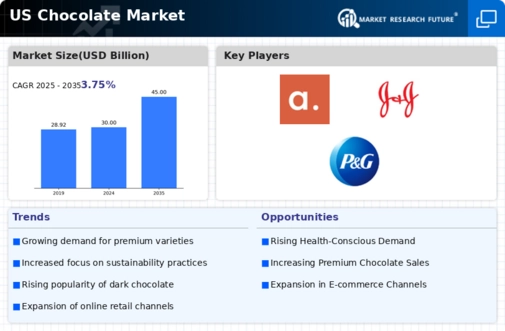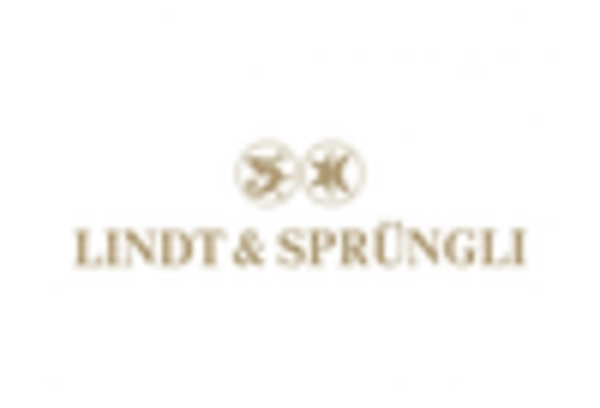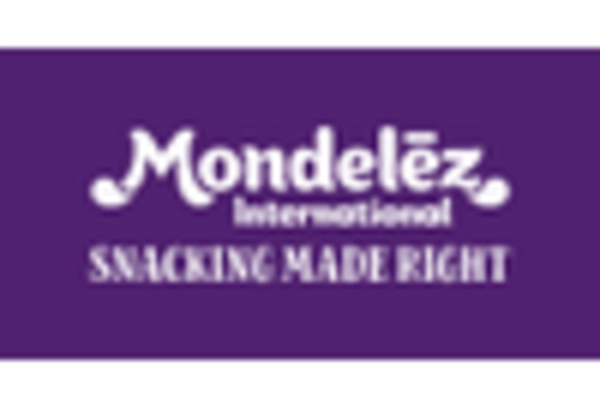Impact of E-commerce Growth
The rise of e-commerce is reshaping the chocolate market in the US, providing consumers with unprecedented access to a wide variety of products. Online sales of chocolate have surged, with estimates indicating a growth rate of over 15% annually. This shift is particularly beneficial for niche brands and artisanal producers who may struggle to compete in traditional retail environments. The chocolate market is responding by enhancing online presence and optimizing supply chains to meet the demands of online shoppers. As convenience becomes a priority for consumers, the ability to purchase chocolate products online is likely to continue driving market growth. Furthermore, the integration of subscription services and personalized offerings is expected to enhance customer engagement and loyalty in the chocolate market.
Seasonal and Gifting Trends
Seasonal events and gifting occasions play a crucial role in the chocolate market in the US. Holidays such as Valentine's Day, Easter, and Christmas see a significant spike in chocolate sales, often accounting for up to 30% of annual revenue for many brands. The chocolate market capitalizes on these occasions by launching limited-edition products and themed packaging, which appeal to consumers looking for gifts. This trend indicates that marketing strategies focused on seasonal promotions can effectively boost sales and brand visibility. Additionally, the rise of experiential gifting, where consumers seek unique and memorable chocolate experiences, is likely to further enhance the importance of seasonal trends in driving market growth.
Evolving Consumer Preferences
In the US, consumer preferences are evolving rapidly, influencing the chocolate market significantly. There is a growing inclination towards dark chocolate, which is often associated with health benefits and a richer flavor profile. Recent surveys indicate that nearly 40% of chocolate consumers prefer dark chocolate over milk chocolate. This shift is prompting manufacturers to innovate and diversify their product offerings to cater to these changing tastes. Additionally, the chocolate market is witnessing an increase in demand for organic and natural ingredients, as consumers become more health-conscious. This trend suggests that brands must adapt to meet the expectations of a more discerning consumer base, which could lead to increased competition and innovation within the market.
Rising Demand for Premium Products
The chocolate market in the US is experiencing a notable shift towards premium and artisanal products. Consumers are increasingly willing to pay a premium for high-quality chocolate, which is often perceived as a luxury item. This trend is supported by data indicating that the premium chocolate segment has grown by approximately 20% over the past year. The chocolate market is adapting to this demand by introducing gourmet options, often featuring unique flavor profiles and high cocoa content. As consumers seek indulgent experiences, brands are focusing on quality over quantity, which is likely to drive further growth in this segment. The emphasis on craftsmanship and unique sourcing methods is also contributing to the appeal of premium chocolate, making it a significant driver in the chocolate market.
Technological Advancements in Production
Technological advancements are transforming the chocolate market in the US, enhancing production efficiency and product quality. Innovations such as automated manufacturing processes and improved quality control systems are enabling manufacturers to produce chocolate at a lower cost while maintaining high standards. The chocolate market is increasingly adopting these technologies to meet rising consumer demand and improve profit margins. Furthermore, advancements in food technology are allowing for the development of healthier chocolate options, such as sugar-free and low-calorie varieties, which appeal to health-conscious consumers. This trend suggests that ongoing investment in technology will be essential for companies aiming to remain competitive in the evolving chocolate market.

















Leave a Comment